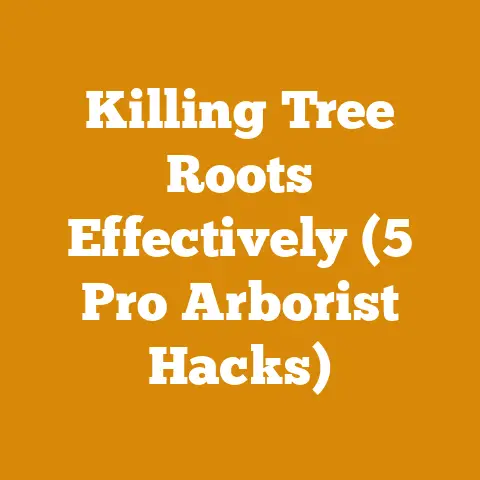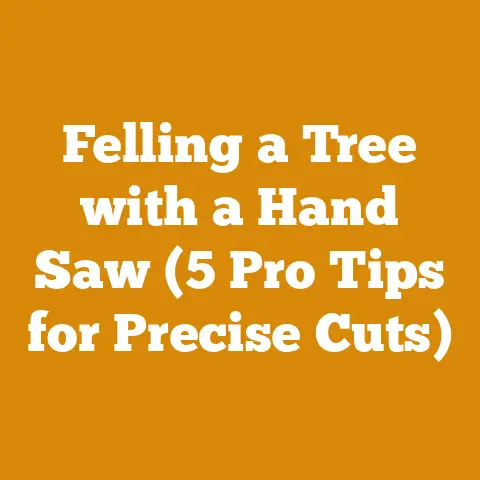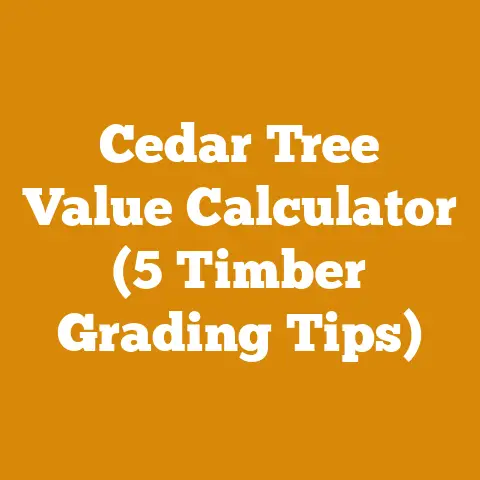Stump Grinder Service Cost (5 Pro Tips for Accurate Quotes)
Let’s talk about something that often gets overlooked when dealing with tree removal: stump grinding. And more specifically, how to get an accurate quote for stump grinder service cost. After all, nobody wants to be surprised by hidden fees or inflated prices. As someone who’s spent years felling trees, processing wood, and even running a small firewood business, I’ve learned a thing or two about this process. I’ve seen firsthand how a poorly handled stump can be a constant nuisance, attracting pests, hindering landscaping, and even posing a tripping hazard.
Getting a fair price for stump grinding is crucial, whether you’re a homeowner, a contractor, or anyone in between. It’s not just about finding the cheapest option; it’s about understanding what you’re paying for and ensuring you get the quality service you deserve.
Stump Grinder Service Cost: 5 Pro Tips for Accurate Quotes
Here are my five top tips, gleaned from years of experience, to help you navigate the world of stump grinding quotes and avoid getting ripped off.
1. Know Your Stump: Size, Species, and Accessibility Matter
This is the foundation of getting an accurate quote. Think of it like this: a small, easily accessible pine stump is a quick job, while a massive, partially buried oak stump tucked away in a hard-to-reach corner is a different beast altogether.
- Size: Stump size is usually measured by diameter at its widest point. Use a tape measure to get an accurate reading. A 12-inch stump is going to be significantly cheaper to grind than a 36-inch stump. The larger the diameter, the more time, effort, and wear and tear on the machine.
- Species: Different tree species have different wood densities. Hardwoods like oak, maple, and hickory are much harder to grind than softwoods like pine, fir, and spruce. The denser the wood, the slower the grinding process and the more strain on the equipment. I once underestimated the grinding time for a massive hickory stump in my own yard. I figured a few hours, but it took almost a full day! The contractor actually had to upgrade his grinder midway through the job.
- Accessibility: Can the stump grinder easily access the stump? Are there fences, sheds, or other obstacles in the way? Are there underground utilities nearby? Limited access can significantly increase the labor involved and potentially require specialized equipment, like a smaller, more maneuverable grinder. I had a job where a stump was located behind a newly built fence. The only way to get the grinder in was to remove a section of the fence, which added to the overall cost.
- Root System: Is the stump part of a larger root system? Sometimes, what appears to be a single stump is actually connected to other roots just below the surface. Grinding these interconnected roots can add to the complexity and cost of the job. Probe around the stump with a shovel or metal rod to check for connecting roots.
- Burial Depth: How far below the surface do you want the stump ground? Most contractors will grind 6-12 inches below grade, which is sufficient for planting grass or shrubs. If you plan to build over the area, you may need to grind deeper, which will increase the cost.
- Pro Tip: Take clear photos of the stump from multiple angles, highlighting its size, species (if you know it), accessibility, and any potential obstacles. Send these photos to potential contractors along with your initial inquiry. This will allow them to provide a more accurate estimate.
2. Understand Different Pricing Models: Hourly vs. Per-Stump vs. By-Diameter
Stump grinding services typically use one of three pricing models: hourly, per-stump, or by-diameter. Understanding the pros and cons of each model is crucial for making an informed decision.
- Hourly Rate: The contractor charges a fixed rate per hour for their time. This model can be advantageous for smaller, easily accessible stumps, as the job may be completed quickly. However, it can also be risky if the contractor is inefficient or encounters unexpected problems. I once hired a contractor who charged an hourly rate, and he spent a significant amount of time “troubleshooting” his equipment. The final bill was much higher than I had anticipated.
- Pros: Can be cost-effective for small, easy jobs.
- Cons: Risk of overcharging if the contractor is inefficient. Difficult to estimate the total cost upfront.
- Example: $150 per hour, with a minimum charge of 2 hours.
- Per-Stump Rate: The contractor charges a fixed price for each stump, regardless of its size or complexity. This model is often used for small to medium-sized stumps and can provide cost certainty. However, it may not be the best option for very large or difficult stumps, as the contractor may underbid and then cut corners or try to renegotiate the price.
- Pros: Provides cost certainty. Simple and straightforward.
- Cons: May not be cost-effective for large or complex stumps. Contractors may rush the job to maximize profit.
- Example: $100 per stump for stumps under 12 inches in diameter.
- By-Diameter Rate: The contractor charges a price per inch of stump diameter. This model is generally considered the most fair and accurate, as it directly reflects the amount of work involved. However, it’s important to get a clear understanding of how the diameter is measured and what the price per inch includes.
- Pros: Most accurate and fair pricing model. Reflects the amount of work involved.
- Cons: Requires accurate measurement of stump diameter. Can be more expensive for very large stumps.
- Example: $5 per inch of stump diameter.
Here’s a table summarizing the pricing models:
| Pricing Model | Description | Pros | Cons | Best For |
|---|---|---|---|---|
| Hourly Rate | Contractor charges a fixed rate per hour. | Cost-effective for small, easy jobs. | Risk of overcharging if inefficient. Difficult to estimate total cost. | Small, easily accessible stumps. |
| Per-Stump Rate | Contractor charges a fixed price per stump. | Provides cost certainty. Simple and straightforward. | May not be cost-effective for large stumps. Contractors may rush the job. | Small to medium-sized stumps. |
| By-Diameter Rate | Contractor charges a price per inch of stump diameter. | Most accurate and fair. Reflects the amount of work involved. | Requires accurate measurement. Can be expensive for very large stumps. | Most stumps, especially medium to large sizes. |
Pro Tip: Always ask for a written quote that clearly specifies the pricing model being used and what is included in the price (e.g., stump grinding to a specific depth, removal of grindings, cleanup).
3. Inquire About Included Services and Potential Extra Costs
A quote is just a starting point. It’s crucial to understand what’s included in the price and what could potentially add to the final bill. Don’t be afraid to ask questions and clarify any ambiguities.
- Grinding Depth: How deep will the stump be ground? As I mentioned earlier, the standard depth is usually 6-12 inches below grade, but you may need to go deeper if you plan to build over the area or plant a large tree. Make sure the quote specifies the grinding depth.
- Grindings Removal: Will the contractor remove the grindings (wood chips and soil) from the site, or are you responsible for disposing of them? Some contractors will remove the grindings and haul them away, while others will simply leave them in a pile. Removing the grindings can add to the cost, but it can also save you a lot of time and effort. I once had a contractor leave a mountain of grindings in my yard, and it took me weeks to clean it up.
- Surface Roots: Will the contractor grind any surface roots that extend beyond the main stump? Surface roots can be a tripping hazard and can also interfere with landscaping. Make sure the quote includes grinding of surface roots if necessary.
- Rock Removal: Will the contractor remove any rocks or debris that are embedded in the stump? Rocks can damage the grinding equipment and slow down the process. Some contractors will charge extra for rock removal.
- Utility Location: Is the contractor responsible for locating underground utilities before grinding? Hitting a gas line or electrical cable can be extremely dangerous and expensive. Make sure the contractor is aware of the importance of utility location and that they take the necessary precautions.
- Travel Fees: Does the contractor charge a travel fee? Some contractors will charge a fee for traveling to your location, especially if you are located outside of their service area.
- Permits: Are any permits required for stump grinding in your area? Some municipalities require permits for tree removal and stump grinding. Make sure you are aware of any permit requirements and that the contractor is properly licensed and insured.
- Cleanup: What does the cleanup process entail? Will the contractor rake the area, fill in the hole with topsoil, and seed the area? A thorough cleanup can make a big difference in the overall appearance of your yard.
- Hidden Obstacles: What happens if they encounter unexpected obstacles, like buried concrete or large rocks? It’s important to discuss how these situations will be handled and how they might impact the cost. I had a job where the stump was partially buried in concrete from an old fence post. The contractor had to use a jackhammer to break up the concrete before he could grind the stump, which added to the cost.
- Pro Tip: Create a checklist of all the services you expect to be included in the quote and use it to compare quotes from different contractors.
4. Check Credentials, Insurance, and References: Don’t Skimp on Due Diligence
Hiring a qualified and reputable contractor is essential for ensuring a safe and satisfactory job. Don’t just go with the cheapest option without doing your homework.
- License and Insurance: Verify that the contractor is properly licensed and insured. A valid license demonstrates that the contractor has met the necessary qualifications and is authorized to operate in your area. Insurance protects you from liability in case of accidents or property damage. Ask for proof of insurance and verify it with the insurance company.
- Experience: How long has the contractor been in business? A contractor with years of experience is more likely to have the knowledge and skills to handle any challenges that may arise. Ask about their experience with similar jobs and their familiarity with the tree species in your area.
- Equipment: Does the contractor have the right equipment for the job? Different stump grinders are designed for different sizes and types of stumps. A contractor with a wide range of equipment is more likely to be able to handle any stump, regardless of its size or location.
- References: Ask for references from previous clients. Contact the references and ask about their experience with the contractor. Were they satisfied with the quality of the work? Was the job completed on time and within budget? Was the contractor professional and responsive?
- Online Reviews: Check online reviews on sites like Yelp, Google, and Angie’s List. Pay attention to both positive and negative reviews. Look for patterns in the reviews that may indicate recurring problems or strengths.
- Better Business Bureau (BBB): Check the contractor’s rating with the BBB. A high rating indicates that the contractor has a good track record of resolving customer complaints.
- Safety Record: Ask about the contractor’s safety record. Stump grinding can be a dangerous job, and it’s important to hire a contractor who prioritizes safety. Ask about their safety training and procedures.
- Pro Tip: Don’t be afraid to ask tough questions. A reputable contractor will be happy to answer your questions and provide you with the information you need to make an informed decision.
5. Get Multiple Quotes and Compare Apples to Apples
Never settle for the first quote you receive. Getting multiple quotes allows you to compare prices, services, and credentials and ensures you get the best value for your money.
- Contact at Least Three Contractors: Contact at least three different contractors and request a written quote. Provide them with the same information about the stump, including its size, species, accessibility, and desired grinding depth.
- Compare Quotes Carefully: Don’t just focus on the bottom line. Compare the quotes carefully, paying attention to the pricing model, included services, and potential extra costs.
- Ask for Clarification: If you have any questions about a quote, don’t hesitate to ask for clarification. Make sure you understand exactly what you are paying for.
- Negotiate: Don’t be afraid to negotiate the price. Some contractors are willing to negotiate, especially if they are competing for your business.
- Read the Fine Print: Before signing any contract, read the fine print carefully. Make sure you understand the terms and conditions, including the payment schedule, cancellation policy, and warranty.
- Don’t Be Pressured: Don’t be pressured into making a decision. Take your time to compare the quotes and choose the contractor that best meets your needs.
- Consider Value, Not Just Price: Remember that the cheapest option is not always the best option. Consider the value you are getting for your money, including the quality of the work, the included services, and the contractor’s reputation.
- Pro Tip: Create a spreadsheet to compare the different quotes side-by-side. This will help you easily identify the best value.
Example of a Quote Comparison Spreadsheet:
By following these five pro tips, you can get accurate quotes for stump grinding services and avoid getting ripped off. Remember to do your research, ask questions, and compare quotes carefully. With a little effort, you can find a qualified and reputable contractor who will remove your stump safely and efficiently, leaving your yard looking its best.
Additional Considerations:
- Timing: Stump grinding can be done at any time of year, but it’s often easier to schedule during the off-season (fall and winter) when contractors are less busy.
- Soil Conditions: Wet or muddy soil can make it difficult to operate the stump grinder. If possible, schedule the work when the soil is dry.
- Neighborly Considerations: Inform your neighbors about the upcoming work, as stump grinding can be noisy and dusty.
- Wildlife: Be aware of any wildlife that may be living in or around the stump. Take precautions to avoid disturbing or harming them.
My Personal Experience:
I remember one particular job where I was removing a large oak tree for a client. The stump was located in a tight spot between their house and a fence. I got three quotes for stump grinding, and the prices ranged from $300 to $600. The cheapest contractor seemed eager to get the job, but he didn’t ask many questions and didn’t seem to have much experience with stump grinding in tight spaces. The most expensive contractor was very thorough and professional. He took the time to assess the situation carefully and explained his plan for removing the stump without damaging the house or fence. I ended up going with the middle option, a contractor who had a good reputation and reasonable prices. He did a great job, and I was very happy with the results.
Strategic Insights:
- Long-Term Planning: If you are planning to remove multiple trees, consider hiring a contractor who can handle both the tree removal and stump grinding. This can often save you money and time.
- DIY vs. Professional: While it is possible to rent a stump grinder and do the job yourself, it’s generally not recommended unless you have experience and are comfortable operating heavy machinery. Stump grinders can be dangerous, and it’s easy to damage the equipment or injure yourself.
- Landscaping Opportunities: Once the stump is removed, you have a blank canvas to create a new landscaping feature. Consider planting a new tree, creating a flower bed, or building a patio.
Next Steps:
- Assess the stumps you need to remove, noting their size, species, accessibility, and any potential obstacles.
- Research local stump grinding contractors and gather a list of potential candidates.
- Contact at least three contractors and request written quotes.
- Compare the quotes carefully, paying attention to the pricing model, included services, and potential extra costs.
- Check the credentials, insurance, and references of each contractor.
- Negotiate the price if necessary.
- Choose the contractor that best meets your needs and sign a contract.
- Schedule the work and prepare the site.
- Supervise the work and ensure that it is completed to your satisfaction.
- Enjoy your stump-free yard!
By following these steps, you can confidently navigate the process of stump grinding and ensure you get a fair price for a job well done. Remember, a little preparation and due diligence can save you a lot of time, money, and headaches in the long run. Good luck!






